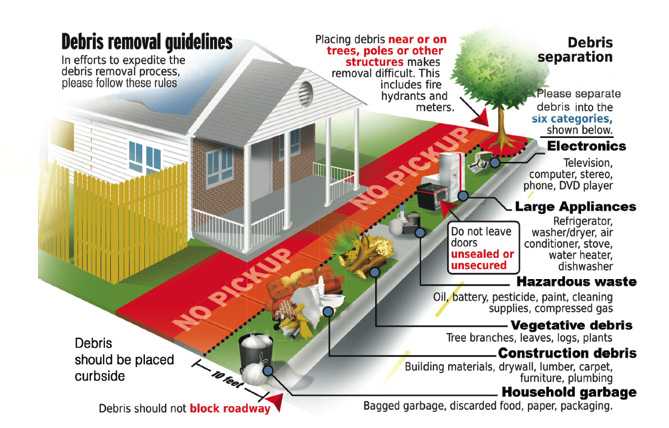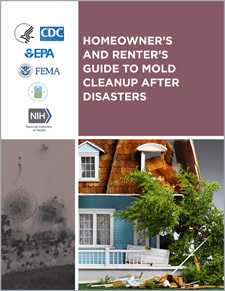Homeowner’s and Renter’s Guide to Mold Cleanup After Disasters
Cleaning up after a flood can pose health risks. You and your family should wait to re-enter your home until professionals tell you it is safe, with no structural, electrical or other hazards.
Before you start cleanup activities, contact your insurance company and take pictures of the home and your belongings. Remember – drying your home and removing water-damaged items is your most important step for preventing mold damage.
Is There a Problem?
Was your home flooded? If so, and you were not able to dry your home (including furniture and other items) within 24-48 hours, you should assume you have mold growth. You need to completely dry everything, clean up the mold, and make sure you don’t still have a moisture problem.
You may see or smell mold on clothing, drywall, furniture, cardboard boxes, or books, but it may also be hidden under or behind items like carpet, cushions, or walls.
Mold Basics: How Molds Can Affect Your Health
Key Messages
- Wear personal protective equipment. Wear an N-95 respirator at a minimum, goggles, and protective gloves.
- Use portable generators carefully, outside and away from the home, to avoid carbon monoxide poisoning and fires.
- Ensure the mold cleanup is complete before reoccupying your home.
Exposure to mold can lead to asthma attacks, eye and skin irritation, and allergic reactions. It can lead to severe infections in people with weakened immune systems. Avoid contaminated buildings and contaminated water as much as you can.
Flood water may have carried sewage or chemicals into your home. This could expose you or your family to viruses, bacteria, disease carriers (such as mosquitos), and parasites, as well as mold. To learn more about cleaning and disinfection go to: www.cdc.gov/healthywater/emergency/flood/standing.html.
You can protect yourself and your family from mold exposure by following these steps.
Before You Enter Any Moldy Site:
- Protect yourself and loved ones against hazards. People with breathing problems like asthma or who have weakened immune systems should stay away from moldy sites. Children should not take part in disaster cleanup work. Check for loose power lines or gas leaks. Make sure the electricity and gas are turned off. Look for sagging ceilings or floors or other structural problems. Watch out for wet, muddy, or slippery floors.
- Protect your mouth and nose against breathing in mold: wear at least an N-95 respirator. If you plan to spend a lot of time removing moldy belongings or doing work like ripping out moldy drywall, wear a half-face or full-face respirator. Basic information on using it is in OSHA’s general respiratory protection guidance.
- Protect your skin. Wear protective gloves (non-latex, vinyl, nitrile, or rubber). Do not touch mold or moldy items with bare hands.
- Protect your eyes. Wear goggles that provide complete eye protection. Choose goggles designed to keep out dust and small particles. Safety glasses or goggles that have open vent holes will not protect you against dust and small particles.
After You Leave a Mold Site:
- Protect yourself and loved ones. Shower and change your clothes. This will help you avoid carrying mold and other hazards back to your current living quarters.
Should I Do This Myself?
This job may be too difficult or dangerous for you. It may be best to get help from experienced and qualified professionals if you can. Hire a mold inspection or remediation professional affiliated with or certified by the National Environmental Health Association (NEHA), the American Industrial Hygiene Association (AIHA), the Institute of Inspection, Cleaning and Restoration Certification (IICRC), or American Council for Accredited Certification (ACAC) to inspect, repair, and restore the damaged parts of your home. Your state also may regulate mold remediation.
Sampling for mold is not usually recommended. Understanding the results can be difficult, and no matter what kind of mold is in your home, you need to clean it up and fix the moisture problem.
If I Must Do This Myself, How Can I Do It Safely?
Follow these steps:
- Put on the personal protective equipment described above to protect your eyes, nose, mouth, and skin.
- Remove standing water and wet materials. Use a wet vacuum to remove water from floors, carpets, and hard surfaces. Dry your home and everything in it as quickly as you can – within 24 to 48 hours if you can.
- Open all doors and windows when you are working and leave as many open as is safe when you leave.
- Open inside doors, especially closets and interior rooms, to let air flow to all areas. Take doors off their hinges if you need to.
- Open kitchen cabinets and bathroom vanity doors; remove drawers, wipe them clean, and stack them to dry.
- Open the attic access to let air flow to the attic. Before you open the attic door, make sure nothing will fall on you.
- When electricity is safe to use, use fans and dehumidifiers to remove moisture. Do not use fans if mold has already started to grow, because the fans may spread the mold.
- Clean with water and a detergent. Remove all mold you can see. Dry right away.
- If you use cleaning products, do not mix cleaning products together. DO NOT mix bleach and ammonia because it can create toxic vapors.
- Painting or caulking over mold will not prevent mold from growing. Fix the water problem completely and clean up all the mold before you paint or caulk.
- Throw away items that can’t be cleaned and dried. Throw away anything that was wet with flood water and can’t be cleaned and dried completely within 24 to 48 hours. If you have precious items that you want to preserve, follow these guidelines from the Smithsonian Institute: www.si.edu/mci/english/learn_more/taking_care/mnm.html.

Safety Tips on Using Portable Generators
- If you use a portable generator for electricity use CAUTION to avoid carbon monoxide poisoning and fires.
- Use portable generators OUTSIDE and at least 20 feet away from buildings.
- Do not use portable generators inside your house or garage.
- Do not put portable generators on balconies or near doors, vents, or windows.
- Do not use portable generators near where you or your children are sleeping.
- Never refuel a generator while it is hot.
- For more information, go to: www.osha.gov/OshDoc/data_Hurricane_Facts/portable_generator_safety.pdf
Am I Done?
- If you still see or smell mold, you have more work to do. After a remediation, there should be no signs of water damage or mold growth.
- You may need to ask a mold remediation professional to know whether your mold problem is completely fixed. As noted in the “Should I do this myself?” section, sampling for mold is not usually recommended; instead, a careful inspection of the work area for completion of the cleanup and absence of mold-related odors is usually appropriate.
- If you have health problems that get worse when you return home, like asthma or allergy attacks or skin or eye irritation, you may still have some mold.
- Page last reviewed: September 16, 2017
- Page last updated: September 16, 2017
- Content source:


 ShareCompartir
ShareCompartir
